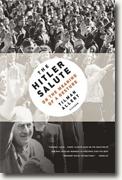The Hitler Salute
Tilman Allert
book reviews:
· general fiction
· chick lit/romance
· sci-fi/fantasy
· graphic novels
· nonfiction
· audio books
· author interviews
· children's books @
curledupkids.com
· DVD reviews @
curledupdvd.com
newsletter
win books
buy online
links
home
for authors
& publishers
for reviewers

 |
The Hitler Salute: On the Meaning of a Gesture Tilman Allert Picador Paperback 128 pages March 2009 |
|
We take our customs of face-to-face greeting for granted, whether handshakes, hugs, casual waves, or such verbal acknowledgements of meeting and parting as “How’ve you been?” and the uber-trite “Have a nice day.” Such seemingly ordinary greetings, the author contends, are “part of the natural history of social encounters, offering fascinating insights into the various ways members of the same species enter into contact with one another.”
When the rite became compulsory, one directive to a students’ league warned that “All who wish to avoid the suspicion of obstructionist behavior will use the Hitler salute.” Non-saluters, if noted, risked prosecution in special courts and punishment ranging from fines to confinement in concentration camps. Along with goose-stepping military units and the ubiquitous swastika, the salute became grimly familiar to Americans through black-and-white newsreels shown in movie theaters before and during World War II, and in post-war documentaries devoted to the whole horrific Nazi era (1933-45). The latter were ever more widely seen with the burgeoning of television in the 1950s. Allert, a professor of sociology and social psychology at the University of Frankfurt, sees contemporary relevance in the subject matter: “We are still living with the history of the fatal gesture that was the Hitler salute, and one of the lessons of that history is that we need to be wary of obligatory rituals, especially when they are imposed from above.” That raises a complex question: why a populace governed within a republic, pre-Hitler, came to assent to a mandated salute and the thicket of rules and strictures that soon grew up around its use. One factor cited is Germany’s crushing defeat in World War I and its people’s subsequent “longing for a homogeneous national culture.” In the economic meltdown that followed that war, “People from all classes felt an enormous sense of betrayal and began to long for a savior who would ease their burdens.” He notes that socio-economic status also played a part in how the salute was viewed. It was, he says, “disproportionately popular” among those of lower status because, in effect, it freed them from subservience to “bourgeois social conventions and mores.” The “fragile sense of superiority” and anti-aristocratic attitudes ascribed to those of bourgeois status seem to have influenced that societal segment’s reaction to the “Heil Hitler” ritual. They “forged their strategies and made their decisions with the anxious certainty...of those who assure themselves that the worst will soon be over.” The typically conservative aristocracy, however, with its traditional ties to the military, “maintained considerable distance from Nazi etiquette, including the greeting,” even while purportedly loyal to the dictatorship during most of its disastrous dozen years. Certain high-ranking officers, however, were among those who took part in the failed 1944 attempt to assassinate the Fuhrer. Exchange of greetings, Allert says, “contains a moral recognition of our dependence on one another.” The Hitler regime’s co-opting of greeting modes and rigid control of the new mode (with punishment for those caught in non-conformance) was, he asserts, a “perversion” which remains a “dark memory.” As a personal footnote to Allert’s thought-provoking subject, it seems valid to mention America’s own experience before World War II with the stiff-armed salute. In U.S. schools for years, the gesture accompanied a pledge of allegiance to the flag (written in 1892). This custom was a fixture within other settings, as indicated by a drawing in a vintage manual illustrating “The Cub Scout Salute”: upraised right arm, open palm facing down. World War II brought an end to this pledge of allegiance mode, replaced by the hand-over-heart gesture still commonly seen. Originally published on Curled Up With A Good Book at www.curledup.com. © Norma J. Shattuck, 2009 |
|
|
|
 Click here to learn more about this month's sponsor! |
|
| fiction · sf/f · comic books · nonfiction · audio newsletter · free book contest · buy books online review index · links · · authors & publishers reviewers |
|
| site by ELBO Computing Resources, Inc. | |
 Brief in length but focused on what is surely a lesser known aspect of Adolph Hitler’s Third Reich, Allert’s book (a translation) describes how German greeting rituals
- some of ancient origin, some largely regional in use - gave way beginning with Nazi assumption of power in 1933. Thus, pleasantries like
Guten Tag (Good Day), Servus (I serve you), Gluck auf (said to be a regional miner-to-miner good luck greeting), and
auf wiedersehen (goodbye) were targeted to be replaced by a “stiff-armed salute and accompanying ‘Heil Hitler’.”
Brief in length but focused on what is surely a lesser known aspect of Adolph Hitler’s Third Reich, Allert’s book (a translation) describes how German greeting rituals
- some of ancient origin, some largely regional in use - gave way beginning with Nazi assumption of power in 1933. Thus, pleasantries like
Guten Tag (Good Day), Servus (I serve you), Gluck auf (said to be a regional miner-to-miner good luck greeting), and
auf wiedersehen (goodbye) were targeted to be replaced by a “stiff-armed salute and accompanying ‘Heil Hitler’.”